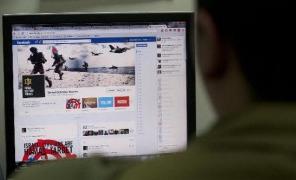
Israeli and Palestinian forces have taken to the Internet to accelerate their wartime propaganda via social media.
As the forces continue their conflict on the ground, they’ve also launched a war of hashtags, English-language tweets and videos on sites like Twitter, YouTube, Facebook and Flickr.
Social networks have been used in recent years to get out information during a government crackdown in Iran, to topple political leaders, to sway voters in the 2012 U.S. presidential election, and to get information about loved ones during natural disasters.
Now social media is being used to try to sway the minds of people around the world about the growing conflict in the Middle East.
“This is a really natural move for social media,” said Patrick Moorhead, an analyst with Moor Insights & Strategy.
“Recipients see the information on social media and assume it’s fresher, more personal and uncensored, even if it could still be spin. This could absolutely sway a political outcome. It just takes one picture or video of a personal atrocity to start a movement.”
After an escalating series of skirmishes and attacks between Israeli and Palestinian militants in recent months, the conflict has expanded into a mobilisation of troops, days of missile strikes and a growing list of casualties.
As the fighting increased, both sides posted to Twitter, YouTube and Facebook in efforts to influence opinions around the world.
In the past, warring countries might drop leaflets or use Tokyo Rose to spread their propaganda. Now they send a 140-character tweet, or post a twitpic or video.
The Israeli Defence Forces, tweeting under IDFSpokesperson, is one of several Twitter accounts from the Israeli government commenting on the operation. Using hashtags like #Israelunderfire and #Pillarofdefense, the IDF is putting out information about rocket attacks on Israel, as well as using tweets to refute statements made by critics.
The IDF is also posting photos and videos of missile launches and damage caused by strikes. One YouTube video shows what is claimed to be the assassination of Hamas military leader Ahmed al-Jabari. It has been viewed more than 2 million times since it was posted Wednesday.
The IDF this week also launched a blog, chronicling strikes and counter-strikes in a flow of updates. However, as of early Friday afternoon Eastern Time, the blog was unavailable.
Not to be outdone, tweeting under the handle alqassamBrigade, the Al Qassam Brigades, the military wing of the Palestinian group Hamas, has also been speaking up about the conflict, posting information about missile attacks.
The group also confirmed the death of Al-Jabari in a tweet: “#Hamas mourns the leader Ahmed al-Jabari and his bodyguard al-Hams,” it read.
AlqassamBrigade also posted a YouTube video of what appears to be a downed unmanned Israeli drone. To go along with it, they tweeted, ”idfelite enjoy this>> losers.”
The video has been viewed more than 30,000 times.
“These posts definitely do have an impact on not only local opinions, but also world opinions,” said Jim McGregor, an analyst with Tirias Research. “In that respect, support, in the form of politics or other resources, may impact the outcome of the conflict. I have friends in Lebanon, and seeing the images from my friends definitely makes the violence real.”
Zeus Kerravala, an analyst with ZK Research, said taking this kind of violent conflict to social networks makes sense.
“It lets them reach more people faster,” he added. “Think about the multiplier effect with people retweeting and reposting.”
Social media, according to Kerravala, has changed the way people communicate around the world.
However, a dose of scepticism is needed when viewing any of these tweets, photos or videos, the analysts noted. The information is being put out there by a biased, one-sided machine.
An online ruckus erupted in the last few weeks when people tweeting for the Al Qassam Brigade posted a photo of a child supposedly killed in Gaza by an Israeli rocket attack. It was later revealed that the photo came from an October incident in Syria.
Even if the information is accurate, some of the images may be extremely graphic and unsettling to view.
“I have received some [images] that I wish I had not,” McGregor said. However, “you may not be receiving correct information, just as quickly as someone can post inaccurate information, someone else can discredit it. Like all other information on the Internet, it should be taken with some level of scepticism.”


